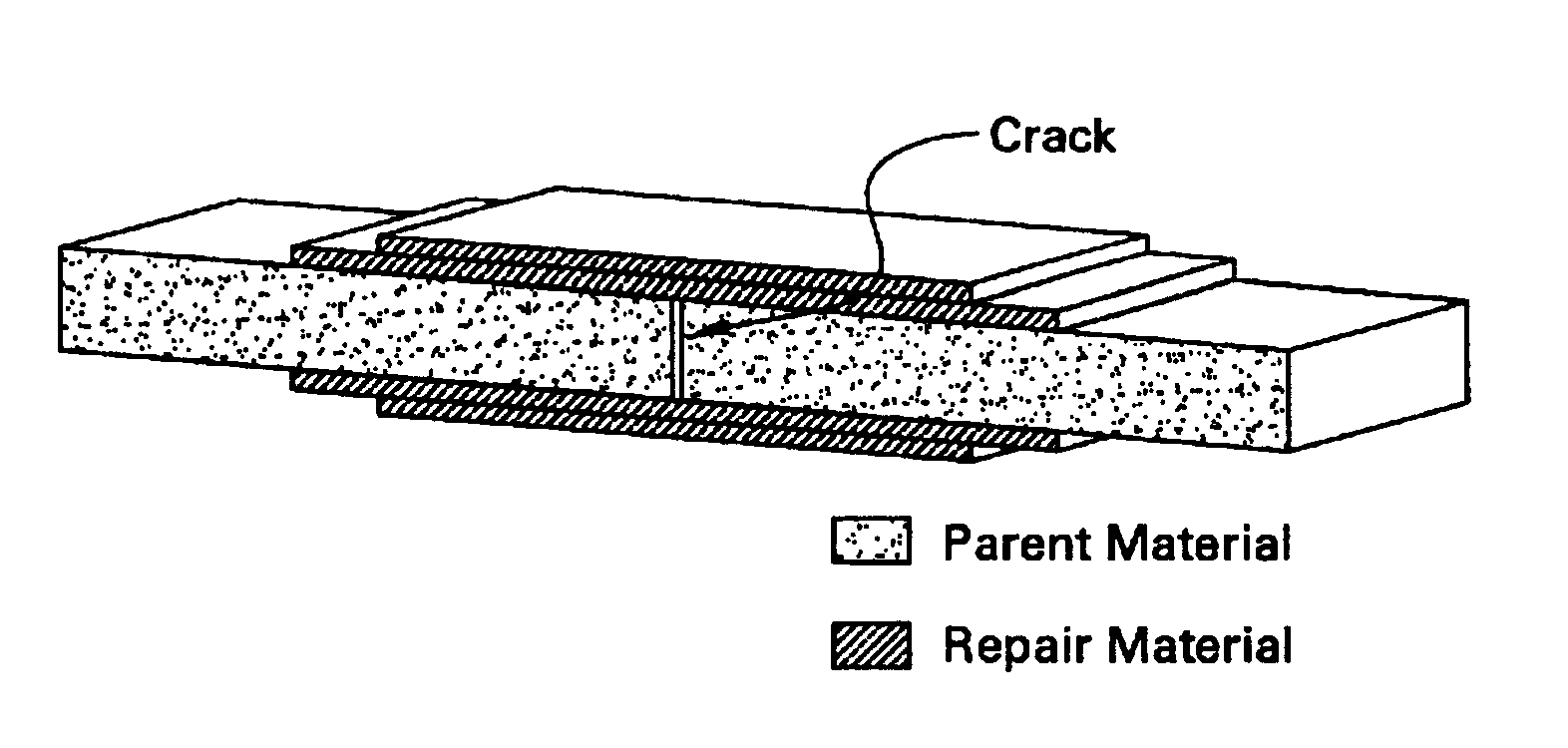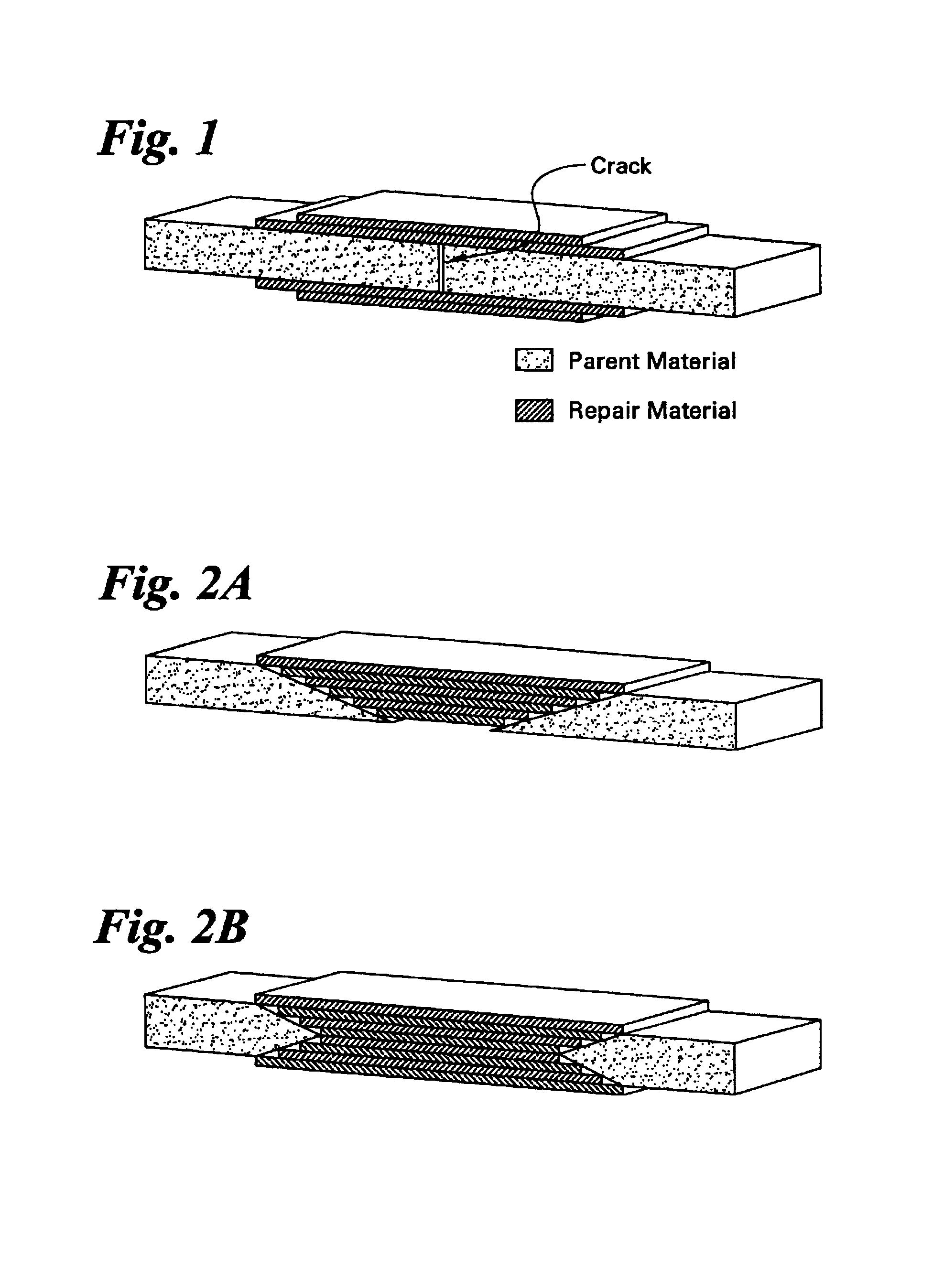Method for repairing articles of ceramic composites
a technology of ceramic composites and repair methods, applied in the direction of sustainable transportation, mechanical equipment, machines/engines, etc., can solve the problem of quite expensive cmcs
- Summary
- Abstract
- Description
- Claims
- Application Information
AI Technical Summary
Benefits of technology
Problems solved by technology
Method used
Image
Examples
example 2
Repair by Applying an External Patch of Hi-Nicalon.TM. Fiber-Reinforced Prepreg Tape to a Melt-Infiltrated Slurry Cast Si--SiC Matrix Composite Reinforced with Tyranno-ZMI.TM. SiC Fibers
Two melt-infiltrated slurry cast Tyranno-ZMI.TM. SiC--SiC composite bars, each having a dimension of about 10 cm.times.1.25 cm.times.0.25 cm, were cut from a large plate. The surfaces of one of the bars were grit-blasted to remove residual layer of metal that was left behind during the fabrication of the plate. The metal residue on the as-fabricated surfaces of the second bar was removed by grinding. Both bars were cut into halves across the long dimension. The two halves of each bar were re-assembled. Two layers of sections of Hi-Nicalon.TM. prepreg tape were laid up on each of the grit-blasted surfaces of the bar and across the cut to cover an area about 2.5 cm on either side of the cut. The fibers in the prepreg tapes were applied to surfaces of the bar as exhibited in FIG. 1 and aligned to be per...
example 3
Repair by Applying a Plug Patch of Hi-Nicalon.TM. Fiber-Reinforced Prepreg Tape to a Melt-Infiltrated Fiber-Reinforced Prepreg Hi-Nicalon.TM. Composite Substrate
A tapered hole having a shape of an inverted prism, as shown in FIG. 2, was machined into a melt-infiltrated prepreg Hi-Nicalon.TM. SiC-in-SiC composite plate having a dimension of about 10 cm.times.2.5 cm.times.0.25 cm. The base of the hole had a large dimension of about 5 cm and a small dimension of about 0.8 cm. The hole was ground through the thickness of the plate. The wall of the hole was cleaned with acetone, and a thin layer of a paste prepared by mixing SiC and carbon powders with a phenolic resin and a binder was painted on the cleaned wall of the hole. The hole was then filled with layers of prepreg tape cut to appropriate dimensions. The patched CMC plate was subjected to a slow binder burnout up to about 750.degree. C. as described in Example 1. A pack consisting of silicon, boron, and boron nitride powders was ...
example 4
Repair by Applying a Plug Patch of Hi-Nicalon.TM. Fiber-Reinforced Prepreg Tape to a Melt-Infiltrated Slurry Cast Si--SiC Matrix Composite Reinforced with Tyranno-ZMI.TM. SiC Fibers
A tapered hole similar to that shown in FIG. 2 having a shape of an inverted prism was machined into a melt-infiltrated slurry cast Tyranno-ZMI.TM. SiC--SiC composite plate having a dimension of about 10 cm.times.3.8 cm.times.0.25 cm. The base of the hole had a large dimension of about 5 cm and a small dimension of about 0.8 cm. The hole was ground through the thickness of the plate. The wall of the hole was cleaned with acetone, and a thin layer of a paste prepared by mixing SiC and carbon powder with a phenolic resin and a binder was painted on the cleaned wall of the hole. The hole was then filled with layers of prepreg tape cut to appropriate dimensions. The patched CMC plate was subjected to a slow binder burnout up to about 750.degree. C. as described in Example 1. A pack consisting of silicon, boro...
PUM
| Property | Measurement | Unit |
|---|---|---|
| temperature | aaaaa | aaaaa |
| temperature | aaaaa | aaaaa |
| diameter | aaaaa | aaaaa |
Abstract
Description
Claims
Application Information
 Login to View More
Login to View More - R&D
- Intellectual Property
- Life Sciences
- Materials
- Tech Scout
- Unparalleled Data Quality
- Higher Quality Content
- 60% Fewer Hallucinations
Browse by: Latest US Patents, China's latest patents, Technical Efficacy Thesaurus, Application Domain, Technology Topic, Popular Technical Reports.
© 2025 PatSnap. All rights reserved.Legal|Privacy policy|Modern Slavery Act Transparency Statement|Sitemap|About US| Contact US: help@patsnap.com



